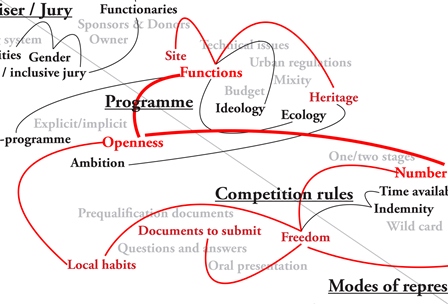Who - or What - "Wins" an Architectural Competition? A Model and a Case Study
DOI:
https://doi.org/10.7577/formakademisk.822Emneord (Nøkkelord):
architectural competitions, Belgium, representation, rhetoric, programme, youth detention centreSammendrag
Architectural competitions are usually seen as a game with only one winner: the architect or team whose proposal is the most convincing. That is certainly a part of the reality, but we argue here for a broader and more nuanced model. In our vision, architectural competitions are a stage upon which a myriad of actors and elements play out a scenario that involves both competition and collaboration on several levels. Depending on the results, the "winners" may be multiple and of very different natures. We call this model "total competition", and are convinced that it has some application not only to competitions, but to architecture in general. After a brief explanation of this conception of things, we will look more closely at a recent Belgian competition (for a Juvenile Detention Center at Fraipont, Belgium, 2011), in order to elucidate its functioning in light of our model. Two findings from this examination are worth underlining. We notice, first of all, a particular and somewhat surprising role played by the nature of the program or brief, where its relative openness seems to have had paradoxical results. Second, we find in the winning entry a strong interaction between different "modes of representation" that seems to have been critical to its success. We conclude with some questions about the generalisability of the model.
Nedlastinger
Publisert
2014-03-12
Hvordan referere
Menon, C., & Vanderburgh, D. (2014). Who - or What - "Wins" an Architectural Competition? A Model and a Case Study. FormAkademisk, 7(1). https://doi.org/10.7577/formakademisk.822
Utgave
Seksjon
Artikler
Lisens
- Forfatteren(e) beholder sin opphavs- og kopieringsrett til eget manuskript, men gir tidsskriftet varig rett til 1) å fremføre manuskriptet for offentligheten i den opprinnelig publiserte digitale form, og 2) å registreres og siteres som første publisering av manuskriptet.
- Forfatteren må selv forvalte sine økonomiske kopieringsrettigheter overfor eventuell tredjepart.
- Tidsskriftet gir ingen økonomisk eller annen kompensasjon for innsendte bidrag, medmindre det er gjort særskilt avtale om dette med forfatteren(e).
- Tidsskriftet plikter å arkivere manuskriptet (inklusive metadata) i den opprinnelig publiserte digitale form, i minst ett dertil egnet åpent tilgjengelig langtidsarkiv for digitalt materiell, som for eksempel i de norske universitetenes institusjonsarkiv innen rammen av NORA-samarbeidet.
Verket vil bli publisert OpenAccess med en Creative Commons 4.0-lisens som tillater alle å lese, dele og tilpasse innholdet, også kommersielt, under lisensvilkårene:
Dette verket må tilskrives/ krediteres på riktig måte, en lenke må gis til CC-BY 4.0-lisensen, og endringer som er gjort må angis på en rimelig måte, men ikke på noen måte som antyder at lisensgiveren støtter deg eller din bruk.



